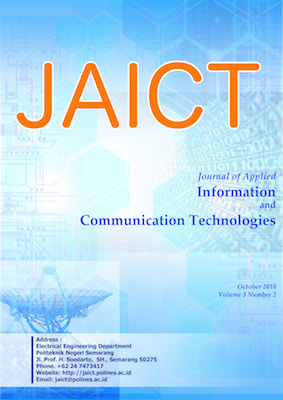Improved communication skills of children with Autism Spectrum Disorder using Augmented Reality based on PECS (Picture Exchange Communication System)
DOI:
https://doi.org/10.32497/jaict.v3i2.1338Keywords:
PECS, Augmented Reality and alternative communication, Autism Spectrum Disorder.Abstract
PECS is a method for developing communication using images to exchange desired objects according to the image, especially for children with autism with non-verbal abilities. PECS has many advantages over other communication learning methods that can encourage autistic children to communicate well. Besides having many advantages, the PECS method itself has many disadvantages. The research conducted was to build an application specifically designed for children with autism by correcting the deficiencies that exist in learning with the PECS method. The application is designed with the guidance of an expert Psychologist Children with Special Needs and refers to previous studies as reference material for application interface design. Application testing involves 4 autistic children from 2 different SLBs. Tests are carried out 2 times for each child to find out the progress of application utilization. The test results show that the proposed application is in accordance with the aesthetic design of the MDA framework that is designed so that it is truly able to be accepted by autistic children while also having a positive impact on them, as well as being able to create a learning environment that is more enjoyable both for children with autism and for teachers.References
Mesibov, G. B., Adams, L. W., & Klinger, L. G. (2013). Autism: Understanding the disorder. Springer Science & Business Media.
Charlop”Christy, M. H., Carpenter, M., Le, L., LeBlanc, L. A., & Kellet, K. (2012). Using the picture exchange communication system (PECS) with children with autism: Assessment of PECS acquisition, speech, social”communicative behavior, and problem behavior. Journal of Applied Behavior Analysis, 35(3), 213”“231.
Sulzer-Azaroff, B., Hoffman, A. O., Horton, C. B., Bondy, A., & Frost, L. (2009). The Picture Exchange System (PECS): What do the data say? Focus on Autism and Other Developmental Disabilities, 24(2), 89”“103.
Light, J., & McNaughton, D. (2012). Supporting the communication, language, and literacy development of children with complex communication needs: State of the science and future research priorities. Assistive Technology, 24(1), 34”“44.
Kagohara, D. M., Meer, L. van der, Ramdoss, S., O”™Reilly, M. F., Lancioni, G. E., Davis, T. N., Sigafoos, J. (2013). Using iPods ® and iPads ® in teaching programs for individuals with developmental disabilities: A systematic review. Research in Developmental Disabilities, 34(1147-156.).
Flores, M., Musgrove, K., Renner, S., Hinton, V., Strozier, S., Franklin, S., & Hil, D. (2012). A comparison of communication using the Apple iPad and a picture-based system. Augmentative and Alternative Communication, 28(2), 74”“84.
Moore, M., & Calvert, S. (2010). Brief Report: Vocabulary Acquisition for Children with Autism: Teacher or Computer Instruction. Journal of Autism and Developmental Disorders, 30(4), 359”“362.
Anwar, A., Rahman, M. M., Ferdous, S. M., & Ahmed, S. I. (2011). A computer gamebased approach for increasing fluency in the speech of the autistic children. In 11th IEEE international conference on Advanced Learning Technologies (ICALT), 2011 (pp. 17”“18).
Frutos, M., Bustos, I., Zapirain, B. G., & Zorrilla, A. M. (2011). Computer game to learn and enhance speech problems for children with autism. In 16th international conference on Computer Games (CGAMES) (pp. 209”“216). IEEE.
Bosseler, A., & Massaro, D. W. (2013). Development and evaluation of a computer-animated tutor for vocabulary and language learning in children with autism. Journal of Autism and Developmental Disorders, 33(6), 653”“669.
Coleman-Martin, M. B., Heller, K. W., Cihak, D. F., & Irvine, K. L. (2015). Using computer-assisted instruction and the nonverbal reading approach to teach word identification. Focus on Autism and Other Developmental Disabilities, 20(2), 80”“90.
Hailpern, J., Karahalios, K., & Halle, J. (2009). Creating a Spoken Impact: encouraging vocalization through audio visual feedback in children with ASD. In Proceedings of the 27th International Conference on Human Factors in Computing Systems, CHI 2009 (pp. 453”“462.). Boston, MA, USA.
Hetzroni, O. E., & Tannous, J. (2014). Effects of a ComputerBased Intervention Program on the Communicative Functions of Children with Autism. Journal of Autism and Developmental Disorders, 34(2), 95”“113.
Whalen, C., Liden, L., Ingersoll, B., Dallaire, E., & Liden, S. (2016). Behavioral Improvements Associated with ComputerAssisted Instruction for Children with Developmental Disabilities. The Journal of Speech and Language Pathology, 1(1), 11”“26.
Madsen, M., Kaliouby, R. el, Eckhardt, M., Hoque, M. E., Goodwin, M. S., & Picard, R. (2009). Lessons from participatory design with adolescents on the autism spectrum. In CHI 2009 (pp. 3835”“3840). ACM Press.
Mariger, H. (2006). Cognitive Disabilities and the Web: Where Accessibility and Usability Meet? Retrieved January 23, 2016, from http://ncdae.org/resources/articles/cognitive/
Taryadi, Kurniawan, Ichwan, (2017). The improvement of autism spectrum disorders child communication ability with PECS method Multimedia Augmented Reality based, Journal of Physics: Conference Series, Series. 947
Frost, L., & Bondy, A. (2012). The Picture Exchange Communication System training manual. (2nd ed.). Cherry Hill, NJ: Pyramid Educational Consultants.
Tincani, M. (2014). Comparing the picture exchange communication system and sign language training for children with autism. Focus on Autism and Other Development Disabilities, 19(3), 152”“163.
Downloads
Published
Issue
Section
License
Authors who publish with this journal agree to the following terms:Authors retain copyright and grant the journal right of first publication with the work simultaneously licensed under a Creative Commons Attribution License that allows others to share the work with an acknowledgement of the work's authorship and initial publication in this journal.
Authors are able to enter into separate, additional contractual arrangements for the non-exclusive distribution of the journal's published version of the work (e.g., post it to an institutional repository or publish it in a book), with an acknowledgement of its initial publication in this journal.
Authors are permitted and encouraged to post their work online (e.g., in institutional repositories or on their website) prior to and during the submission process, as it can lead to productive exchanges, as well as earlier and greater citation of published work (See The Effect of Open Access).






